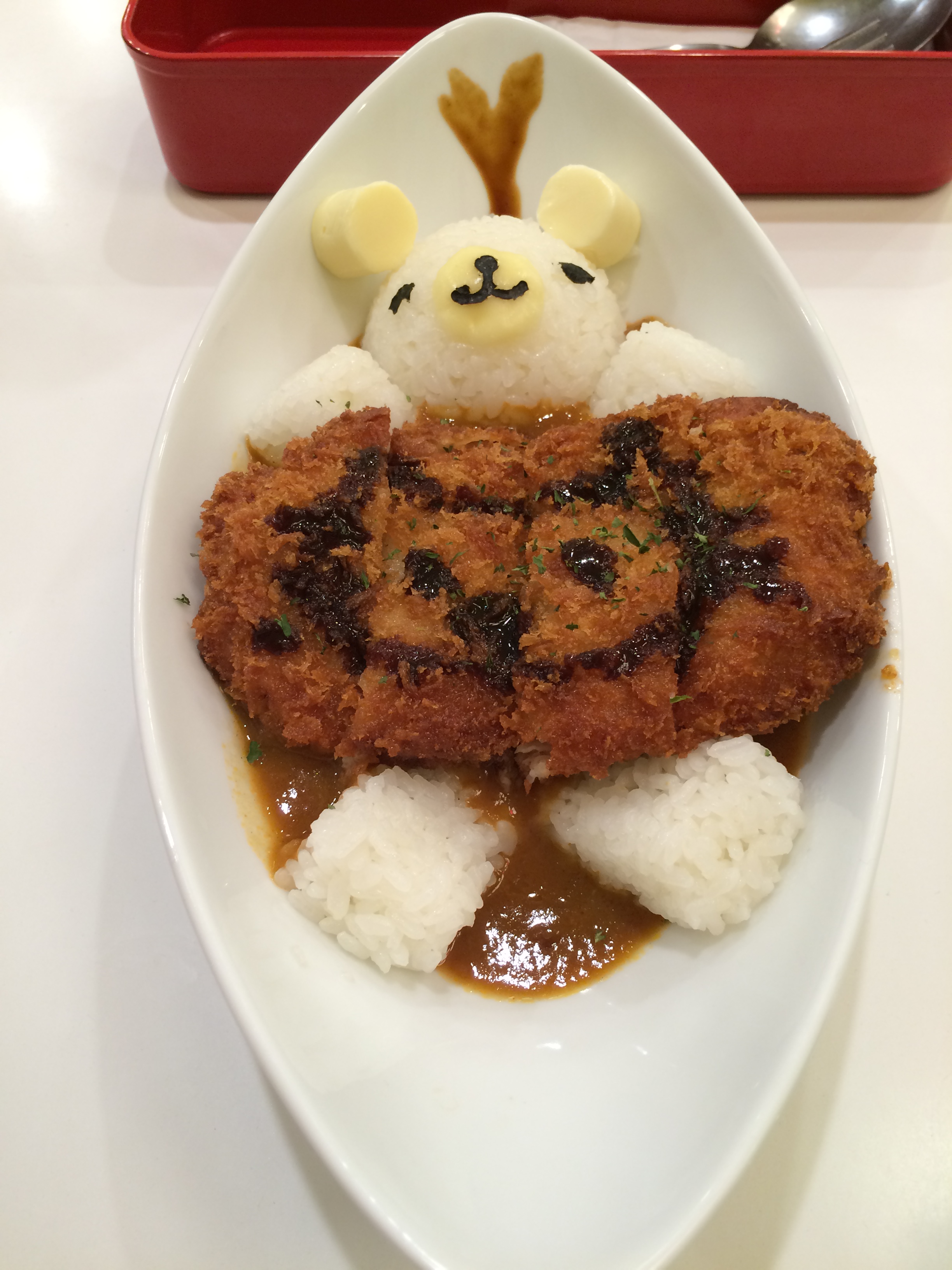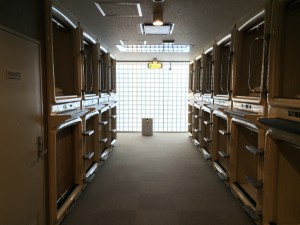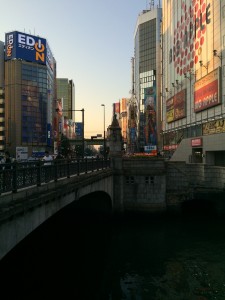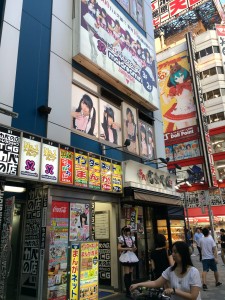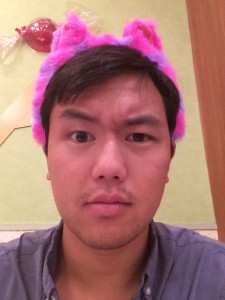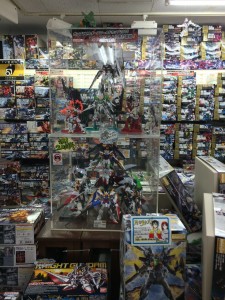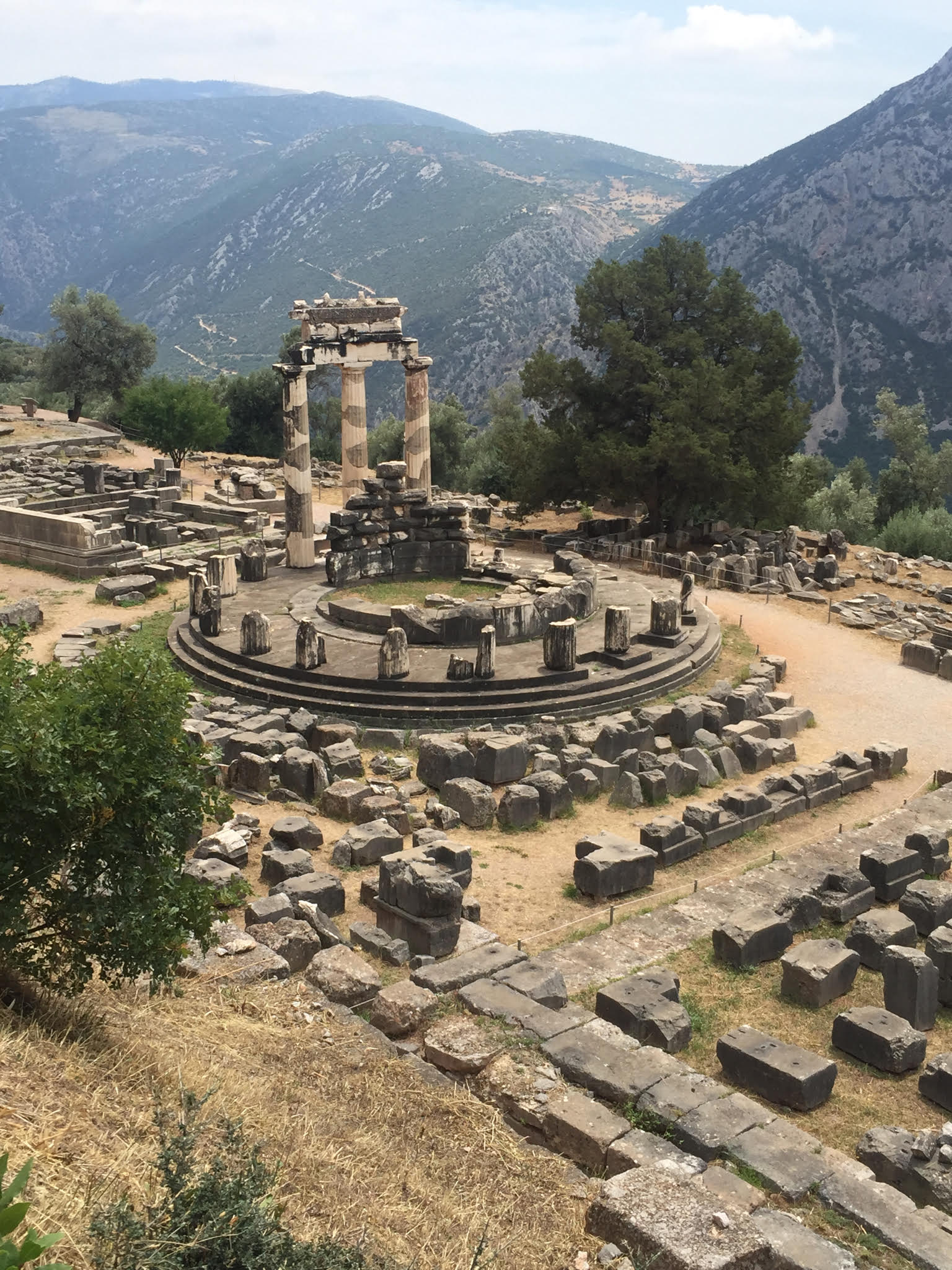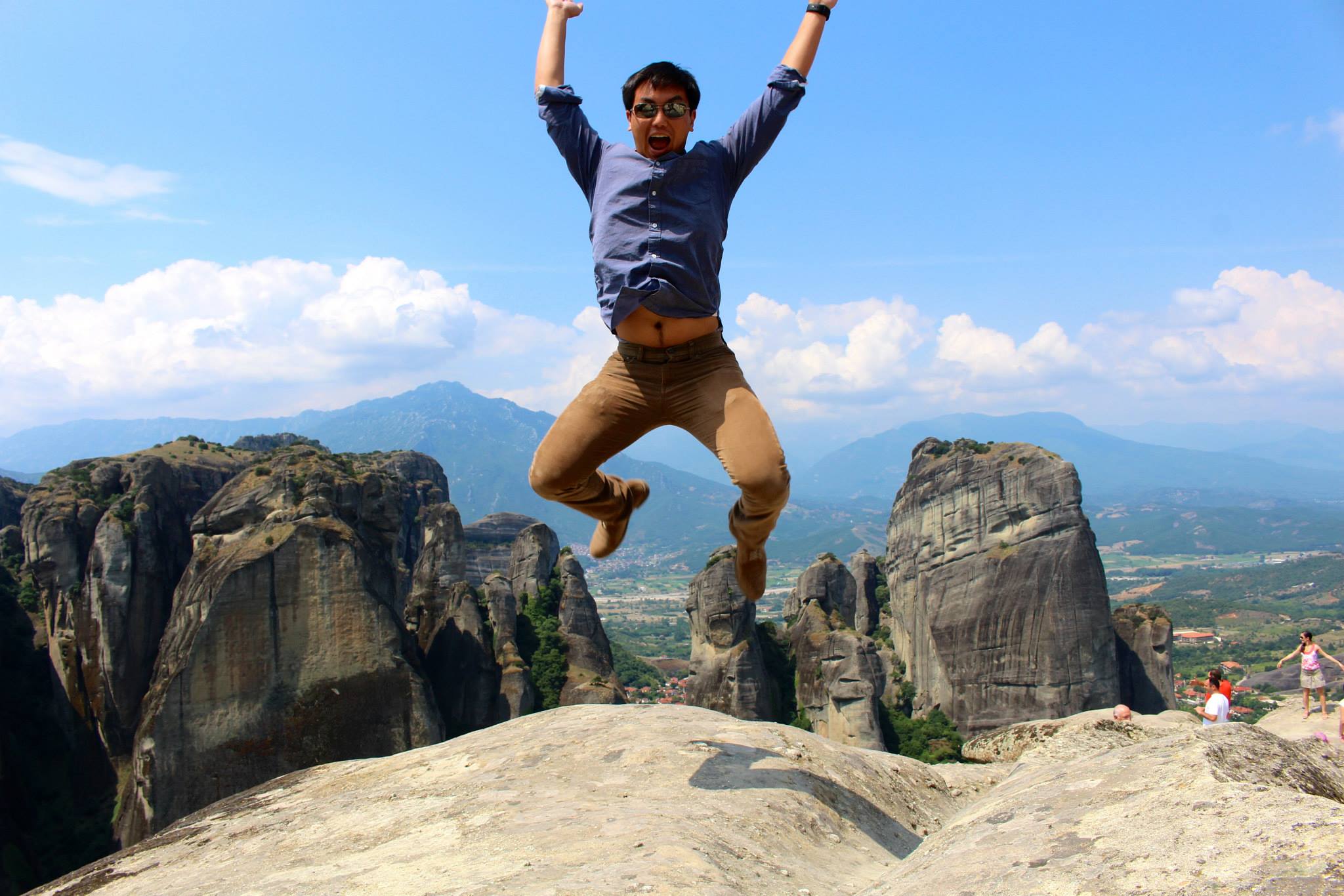Today started bright and early at 9am with healthy servings of jet lag and groans. A shot of espresso as we walked through the streets of early morning Athens helped take the edge off.
First order of business for our first full day in Greece was visiting a travel agency to finish booking a few things that we couldn’t do online like getting tickets for the ferry to San Torini. This unfortunately meant a few hours in a travel agent’s office, but Kristen and I got to wander around and walk while our parents took care of business.
The first thing that struck me about daytime Greece was the prevalence of motorcycles! Everywhere we walked the sidewalk would be lined with parked motorcycles. On the roads, we mostly saw buses, taxis, and motorcycles with the occasional ordinary car.
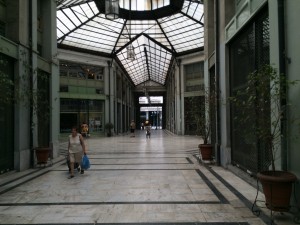
This entire complex had maybe one shop still in business!
The next thing that struck me about walking around in Greece was how many shops were closed. I hadn’t heard much about the financial crisis in Greece before coming to the country, but apparently Greece needs to negotiate terms with the EU by Monday or declare bankruptcy (or something like that, I haven’t been paying full attention). As if to emphasize the economic hardship Greece is feeling, we would walk entire city blocks that had nothing but closed down stores.
Another thing I found interesting was that Athens is fairly clean and litter free despite not having very many public trashcans for people to throw things away in. Maybe cleanliness and order is somehow ingrained in the culture?
Anyway, as we walked along just trying to get lost and explore I learned that people in Greece have no fear. Navigating the city streets can thus be a bit terrifying as cars whiz by and pedestrians waltz through the streets as if the timing were choreographed to fit between traffic. At one point, Kristen and I needed to cross the street and there was an old Greek man getting ready to cross at the same point. We figured we’d be able to follow the old Greek man and just cross when he crossed. Nope. Old Greek man strolls out into the street perfectly in time to walk behind a taxi that had just passed and skip in front of an oncoming bus before reaching the other side. We didn’t have the guts to follow where he led and instead just looked on in surprise as we tried to locate the nearest cross walk.
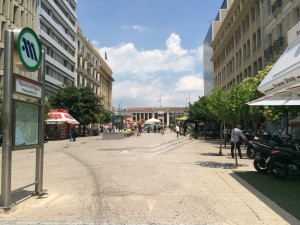
We turned a corner and found this rather interesting building with traditional Greek architecture calling to us from the end.
Roaming around Athens was amazing! I think one of my favorite things about Europe is being able to walk through a seemingly normal city street then turn a random corner and be wowed by history or culture or architecture. In Greece, walking around randomly had us running into old greek ruins thousands of years old or beautifully architected buildings made in their image.
I think one of my other favorite things about traveling is immersing myself in a culture. For me, this usually means getting lost a little bit to experience things that are off the beaten path. It usually means trying something new at every meal–either something I’ve never seen before, something I can only get in this country, or something uniquely done very well in this country. (I am honestly terrified that I will gain a ridiculous amount of weight while abroad because I absolutely love trying new foods.) It also means learning a new language. (I love learning languages! I’m still disappointed I haven’t mastered a second language to fluency, but that’s probably because I keep getting distracted by new ones to learn!)
Usually before every trip I spend some time teaching myself the language of the country I am about to visit. Most of the time I’m starting from scratch, so I don’t even come close to being conversational in the language let alone fluent. But usually I’m able to learn just enough to start picking up little tidbits of people’s conversations and understanding street signs. The real fun comes when I’ve learned enough to start passively learning more as I wander the streets of a new city :).
Unfortunately, since I’m also visiting Taiwan and Japan very soon and I have studied Chinese and Japanese before, I spent most of my time before this Greece trip learning Asian languages. I figured learning 3 languages at the same time might be a bit too much. Since Greek uses a fairly different alphabet, I realized today just how much I take for granted being able to read and pronounce the words I’m seeing even if I don’t know what they mean. In fact, for learning new languages I think the ability to even just pronounce a language is more empowering than one would think.
So today I set myself to learning the Greek alphabet so that I could pronounce the words on street signs and restaurant menus. Greek pronunciation is very similar to what you might expect based on the names of the letters in its alphabet. There are, however, a few letters which are pronounced very differently in Greek than we have been taught in math classes in the States. For example, we typically pronounce “H” as “eta” (eight-a) back home, but in Greek this letter is pronounced “ita” (eat-a). My pronunciation still isn’t perfect–there are some vowel combinations I still don’t get and I always forget that “P” is pronounced with an “r” sound (for “rho”)–but now that I can sound out words I’m realizing that Greek isn’t a particularly hard language! There is a large psychological barrier in needing to learn a new alphabet just to pronounce a language, but many Greek words are very, very similar to their English counterparts. For example, tomato is ντοματα (pronounced ntomata) in Greek. In fact, now that I can pronounce it and am developing an ear for it, Greek actually sounds and works like a lot of other romance languages (in particular, I feel like Greek sounds a little bit like Spanish).
Anyway, after a few excursions from the travel agency (we checked back every so often to see if the parents were done), many newly picked up words, and a couple of snacks, we were finally ready to head to lunch as a family. My parents found this vegetarian/vegan place called Avocado about a half mile away from the Acropolis. Much to my chagrin this place featured no traditional Greek foods, and nothing that I couldn’t particularly find in other countries :(. Lunch was therefore not particularly memorable or worth talking about today. I’m realizing now that if my parents have their way, I won’t get to enjoy any of the amazing foods in Greece!

The BEST baklava I have ever had. How do they make each piece look so perfect?!
After lunch at Avocado, we slowly made our way up to the Acropolis, our main point of interest for the day. Along the way, we stopped at a shop selling baklava and bought a few different pieces. This baklava was literally to die for. I tried making baklava a few months ago and many of friends said they thought it was very good except that the layers needed to stick together better. Today I learned that they have all lied to me. My baklava was nothing, nothing compared to this baklava. I’m not even sure where to start putting my finger on the differences… perfect texture, explosion of sweet honey-filled flavor, and just a hint of… feta? Anyway, this shop also sold chocolate baklava which is also friggin’ amazing.
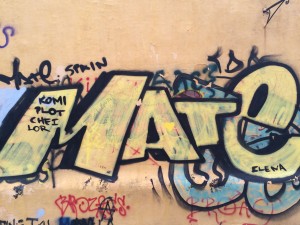
Greek graffiti! I wonder what it says…
There’s a surprising amount of graffiti in Athens and, as we made our way upwards through cute narrow alleyways, we often found ourselves confronted with colorful displays of a more modern kind of art. I wish my ability to read Greek were a bit better so I could actually understand what some of these things say.
When we finally reached the Acropolis, we found that it was quite a hike to reach the top of the hill where the Parthenon, the Propylaia, and the other buildings lie.
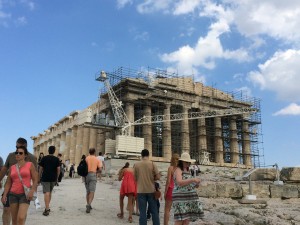
View of the Parthenon from the Propylaia.
I was disappointed to find that I couldn’t walk through the columns of the Parthenon, but was nevertheless in awe of its great figure.
The view from the top of the Acropolis was breathtaking–a complete panoramic view of Athens. Remembering similar scenes from my time in Paris last winter, I have to say that the city skyline in Paris is made even more beautiful by having a fairly uniform and kind of antiquated architecture about it.
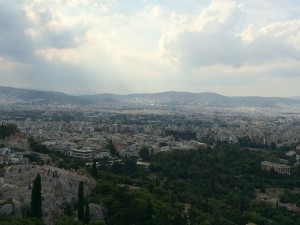
View of Athens from the Acropolis.
Modern buildings in Athens by contrast give the viewer very little sense that this is a city that has stood for thousands and thousands of years.
After the Acropolis, we visited the Acropolis museum. Unfortunately, no pictures were allowed and we were all also hitting a low from sleep deprivation. We walked through the museum, but didn’t linger for very long at the exhibits. I’ve never quite enjoyed seeing Greek statues and engravings in a museum setting as much as seeing them in their natural context.

The beach at Voula, just after sunset.
Finally, we returned to Voula, the district on the outskirts of Athens where we are staying. We quickly changed into swimsuits and walked down to the nearest beach, hoping to catch the sunset on the water. Regrettably, the sun was already lost behind the clouds by the time we reached the beach. Kristen and I nevertheless tested the waters. They were warm and the water was shallow quite a ways out. Even without the sun, we could see that the water was a beautiful light turquoise blue!

The menu at SouvlaKing.
After the beach, we walked to a nearby Greek food stop called SouvlaKing. It wasn’t a particularly grand or memorable place, but we chose it because they had a decent website which featured a menu entirely in Greek with no English translation (I took this as a good sign of authenticity :P). The food was decent–I ordered some kababs stuffed with yogurt–but it was a fairly ordinary food operation which didn’t quite qualify for the label of “sit-down restaurant.” Maybe not the best choice of food.
Dad was still hungry after SouvlaKing, so we headed to a second dinner in a much nicer location.
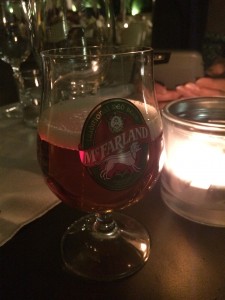
McFarland red beer!
This restaurant was situated on the side of a beautiful lake right beneath a sheer cliffside which reflected itself very clearly in the still water. It was quite a sight! At this restaurant, I had my first “red beer.” (I’m still not sure what makes it special, but it wasn’t terrible by any means.)
Quite an eventful day! We’re staying in Athens through tomorrow before taking traveling to other places in Greece early Sunday morning. Looking forward to what’s in store!



